On my solo hike today, I plan to first walk along the embankment of the Neva River. As I cross the street, I notice that a young mom is struggling with her baby carriage. Many of the curbs here have ramps for strollers or wheelchairs, but this particular corner has nothing of the sort.
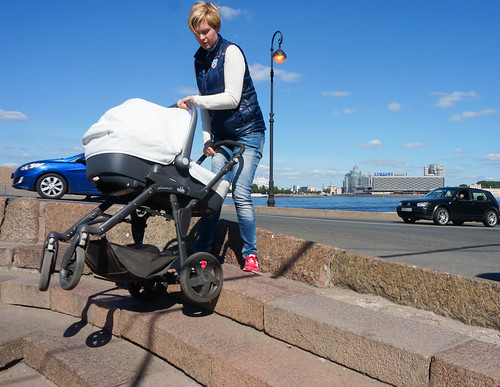
I ask -- can I help?
She demurs. No no, it's okay.
I do a quick assessment in my head and then silently pick up the front of the carriage and we carry it to the level surface. Thank you, she murmurs.
At the other end of the block, the same problem presents itself, only the stairs are going down. I turn around and eye her quizzically. She immediately says -- really, it's easier on this side. I smile and walk on.
This is the kind of stuff I struggle with all the time here. Because I surely know what's going on: pride does not allow for an admission of weakness.
It happened in Poland numerous times when I was growing up there: the (wealthy) visitor comes, he or she helps by handing out a largess -- a present, money, typically tangible things. And sometimes it was greatly appreciated, but at other times it's an insult. As if you're saying -- You obviously need my help. Here, let me do this for you (or give this to you), you lesser person. And this was in Poland, where Americans were and are adored. What must it be like here when an American gives help from her or his elevated position on the world platform?
Sometimes (but you have to think very carefully about when) the best thing you can do is not help. You're saying then: I know you are an equal. (Or perhaps even more than that.)
Perhaps you'll say I'm overthinking this. Just lift the stroller, throw down the money, offer your largess, God damn it! No, I don't think so. Sometimes the best thing you can offer is just one quiet Monalisa smile. Nothing more than that.
the islands
As the week in St. Petersburg draws to a close (we leave Friday), I want to walk. A lot.
St. Petersburg is, of course, a city of waterways and therefore it is a city of islands. Right across the Neva, there are three that I can reach by foot: Pietrograd and the connected to it Zayachy, and then Vasilyevsky.
And so right after breakfast (I have settled on oatmeal... what can I say...) --

I set out alone, heading, as I indicated above, toward the Neva River, then tracing its shore until the Trinity Bridge. There I cross to the first of the islands and after one more bridge, I am on Zayachy. This is where you'll find the fortress that started it all. The one that is so evident in this photo:
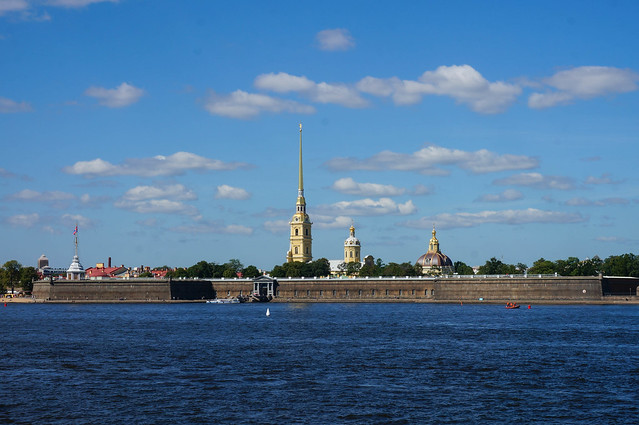
And inside the fortress you'll find the Peter and Paul Cathedral. With only one or two exceptions, all of the tsars are buried here. (I bought my ticket, went inside, saw the graves, went out.) The tower is the second largest in the city (the largest is the TV tower).

It's a relatively warm, sunny day and there are a number of people out for a stroll here. And sun bathers!
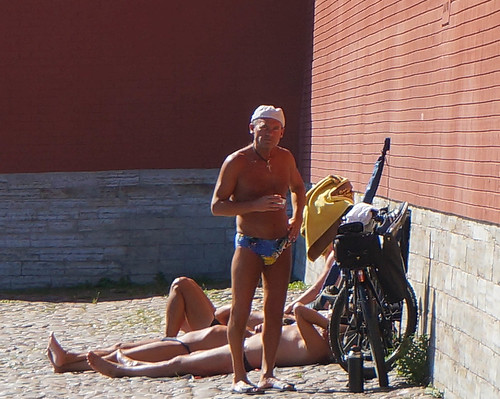
And lovers.
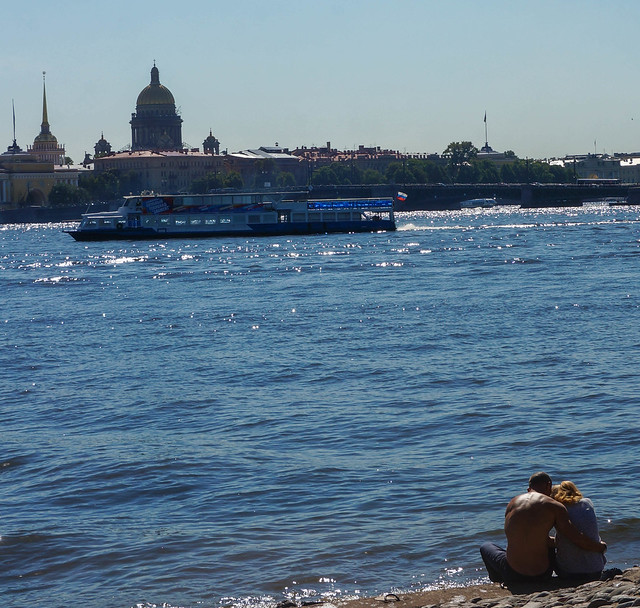
There is a river beach area and you can strip down to your bikini and stare at the Hermitage and the Church on the Spilled Blood across the river.
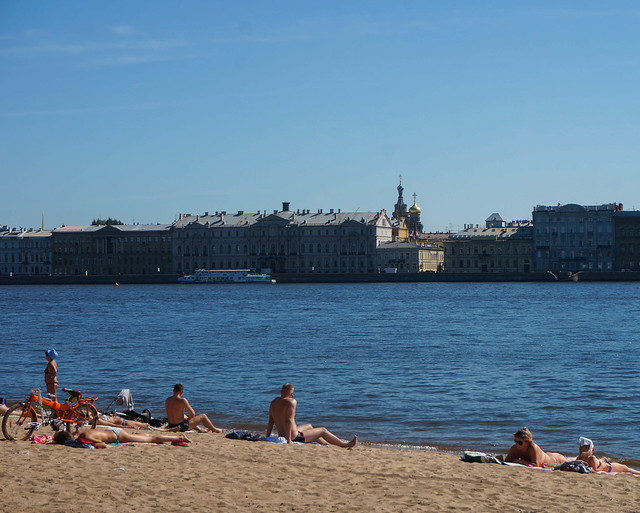
Or, just walk the island and admire the sights. (Including this odd statue of Peter the Great. If you rub his right forefinger, you'll have good luck. I already have good luck so I didn't bother.)
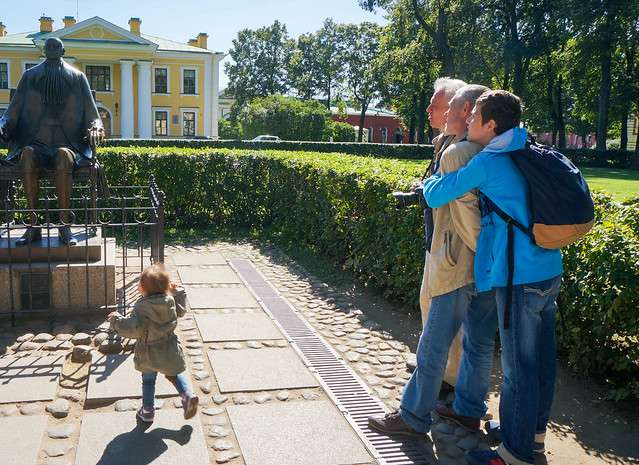
More weddings to admire...
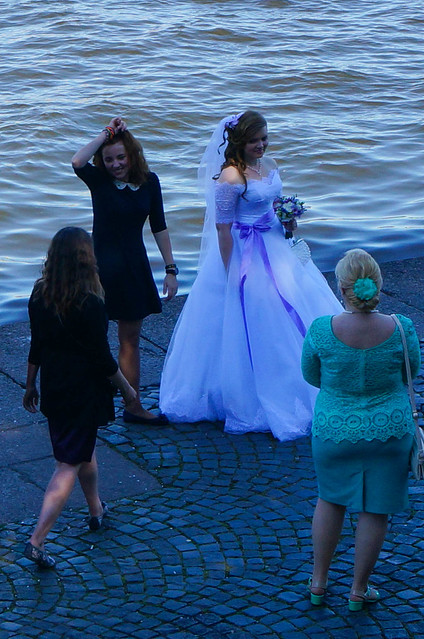
.... more bridges to cross and then I realize that I am straying far from the hotel. If I am to be on time for my scheduled meeting with my friends, I best reconsider taking in another island.
And so I cross the Neva and do something else instead: I ride the metro.
the metro
Using a city's public transportation is as good a way to rub shoulders with the locals as going to the store to buy bread. In a bus, trolley bus or metro car, you can gaze unabashedly at those around you. In St Petersburg, the best place for this is unquestionably on the metro.
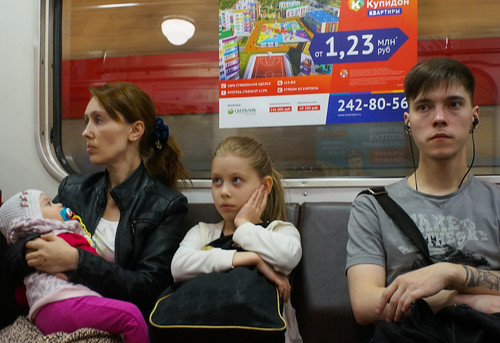
(in the eyes of some, there is sadness, or worry, or both)
The first line of the metro (the red line) was completed here in 1955. The remaining lines soon followed. The city now has a gloriously efficient system of moving people around and this afternoon I devoted one hour to just riding it -- from one stop to the next, getting off at the stations that seemed the most worthy of a closer inspection.
I have four comments (not in order of importance).
For a visitor from the west, the price of a ticket is embarrassingly cheap. At the same time, you wont find many foreigners using the metro. This is the odd thing about St. Petersburg: most visitors come by bus and leave by bus and explore by bus, sticking pretty close to the Hermitage. The metro remains relatively free of outsiders. (As opposed to, say, Paris, where the metro in August will have more tourists than French people. The Parisians are all out on the beaches of the Mediterranean. The visitors dominate.)
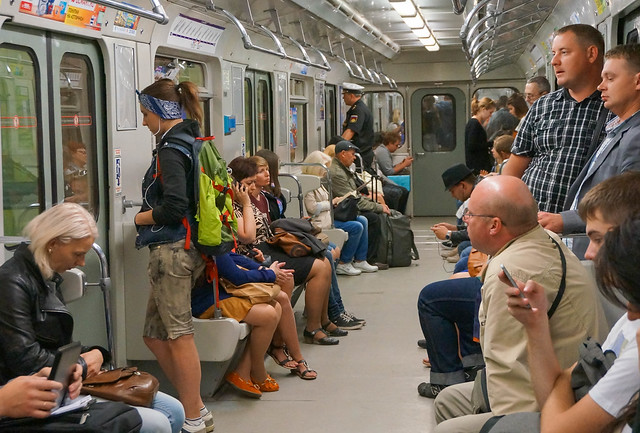
Secondly: the metro system is incredibly efficient. I worried that getting on and off and on again would take forever. Think D.C. metro and how long the wait can be for the next train to pull in, especially in non rush hour periods. Getting on and off would be tediously dull: all that time waiting at the station!
Not here. The trains come every two or three minutes. For a person who wants to get on and off -- it's a dream.
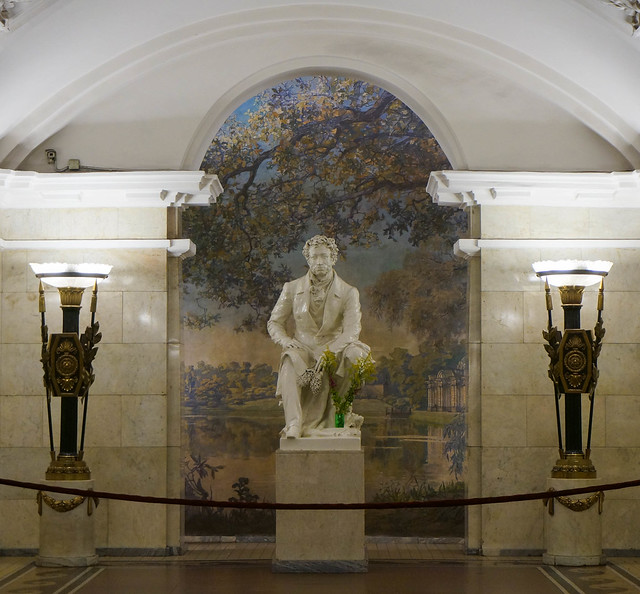
Pushkin Station
Third point: there is no trash, no litter, no graffiti. It is clean down there. Remarkably tidy for a nation that doesn't have the reputation for being pristine. And no, I did not see a cleaning squad attending to human slovenliness. I saw an occasional (but rare) guard, that's all.

And I saw a populace that is proud. Too proud to deface what is regarded as uniquely grand, uniquely theirs.
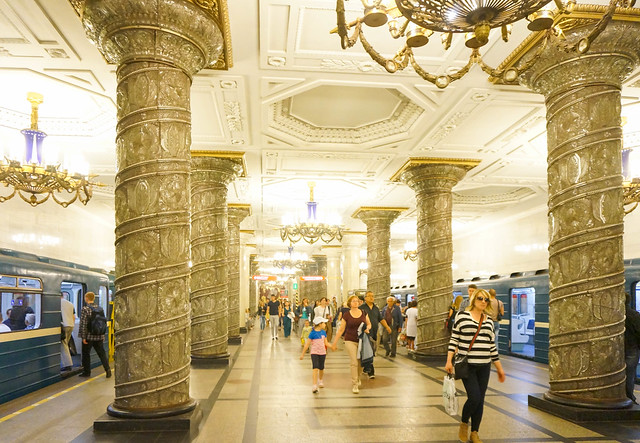
Avtovo Station
Which brings me to the final point: the metro was built in the years just before and after the death of Stalin. The stations are a work of art. Soviet art. There isn't a better place to come face to face with it than at the metro stations.
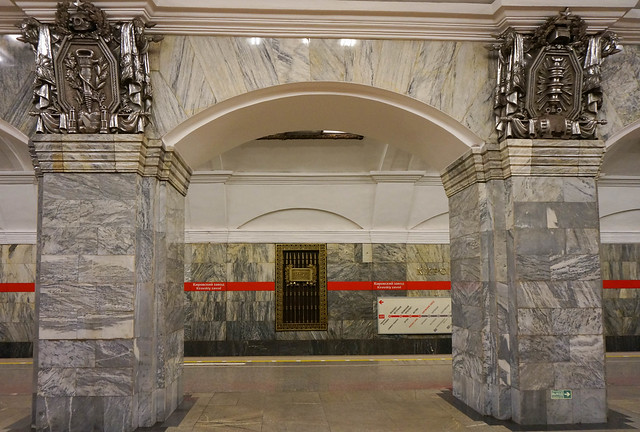
Kirovsky Zavod station
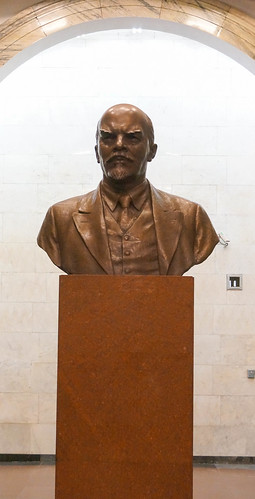
...with Lenin keeping watch
Times have changed since the days of Lenin or Stalin. We're back to Russia now, as opposed to the Soviet Union. And Saint Petersburg, as opposed to Leningrad. But although the city name has changed and the commercial face of Russia has surely changed too, moving further and further from the post-revolution communist rhetoric of its leaders, here -- unlike in Poland -- the monuments to those leaders have, for the most part remained in place. Here's a relief of Stalin and Lenin at the Vosstaniya stop:
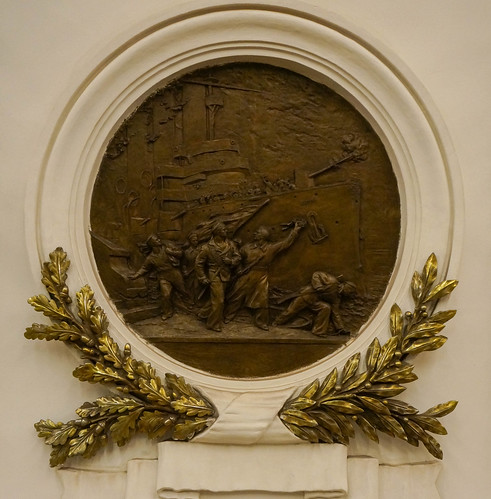
What does this young woman know about the two former leaders of the Soviet Union?
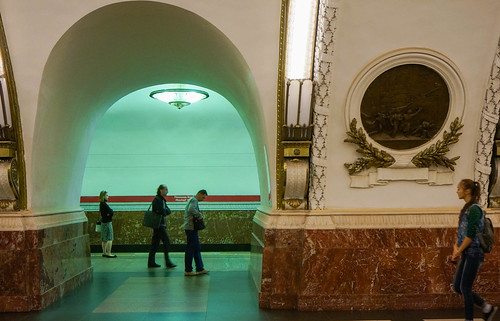
Perhaps this is true to some extent in most countries: we, too, have trouble letting go of glorified images of generals and leaders whose period of governance did not exactly embrace all the values we claim to hold dear. But in Poland, the erasure of a communist past has proceeded rapidly following the return to market capitalism. The changing of Warsaw street names is a prime example of this. Not so here.

Narvskaya Station
the Hermitage, part two
We eat an early meal. While Ernest rests, Diane and I grab a supper at the Bize bakery at 4:30. For me -- a beet salad, borstch with black bread and a macaron.
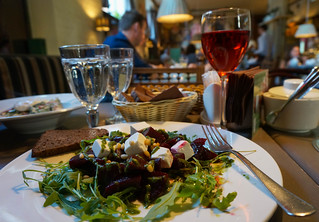
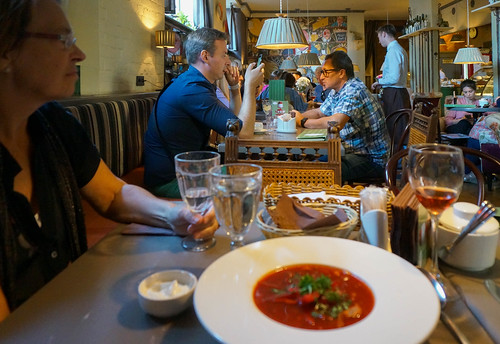
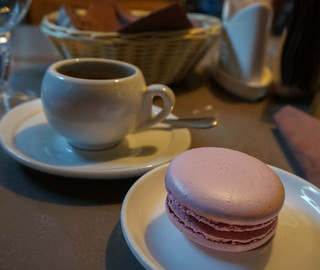
And then we scoot along quickly...
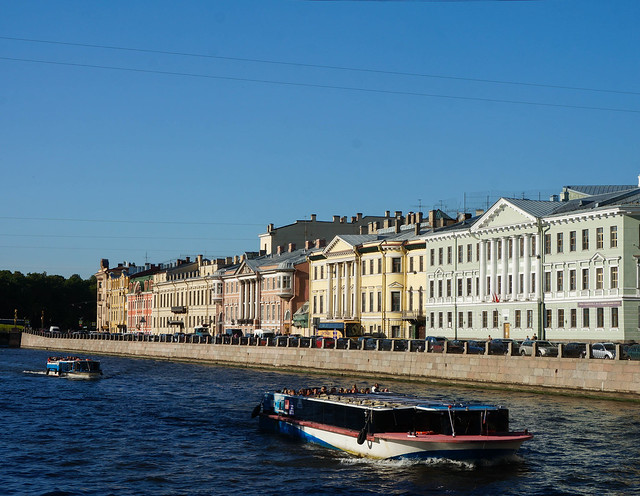
... and shortly after five (today, the museum is open until nine), Diane and I are at the entrance of the General Staff Building of the Hermitage. A few years ago, the powers that be decided to create space here for the Impressionists and the post-Impressionists, to ease up on the congestion at the Winter Palace, where the rest of the art is displayed. The General Staff Building offers dozens of rooms around a courtyard, with great natural light and a beautifully constructed common areas linking it all together. 95% of the art has been moved by now and the whole project will be completed by the end of this year.
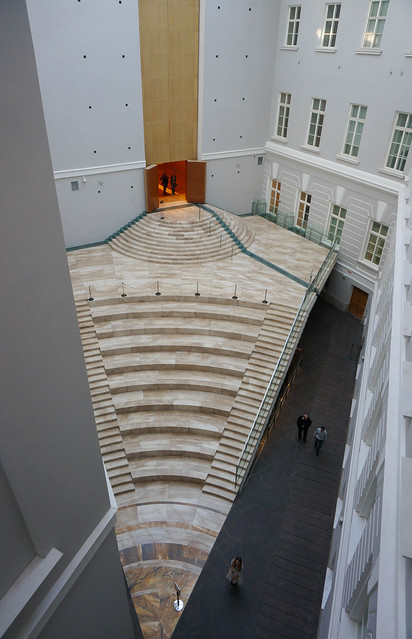
And here is a shocking thing and it is so shocking that I still cannot fully grasp nor understand it. Let me explain: the Hermitage has the single largest collection of Impressionist art in the world. It has two rooms full of Gaugins alone. It has a huge room of Monets, one of Renoirs -- I mean, it's enormously vast and grand. It would not be incorrect to say that I learned to love Impressionism right here, in St. Petersburg (then Leningrad) when I was a mere 15 year old. I saw in the paintings something dreamy and magical. Here is where I began the life-long struggle to look at something with Monet-like eyes. A haystack, a river, a garden -- I understood their simple but exquisite beauty had to be painted in your soul. Honestly, my life changed after that.
In other words, the Impressionist collection is mind blowing!
Now to the shocking point. Brace yourselves:
The museum is almost completely empty.
Here's how a room of Monets felt:
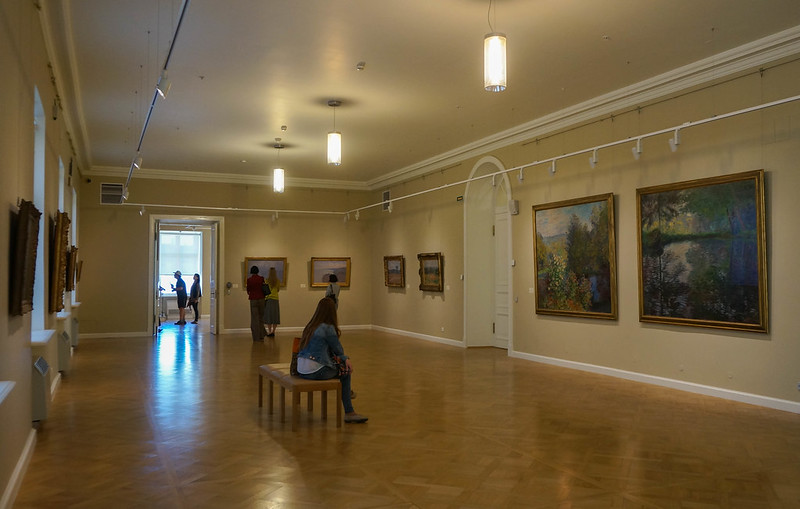
Or of Matisses:
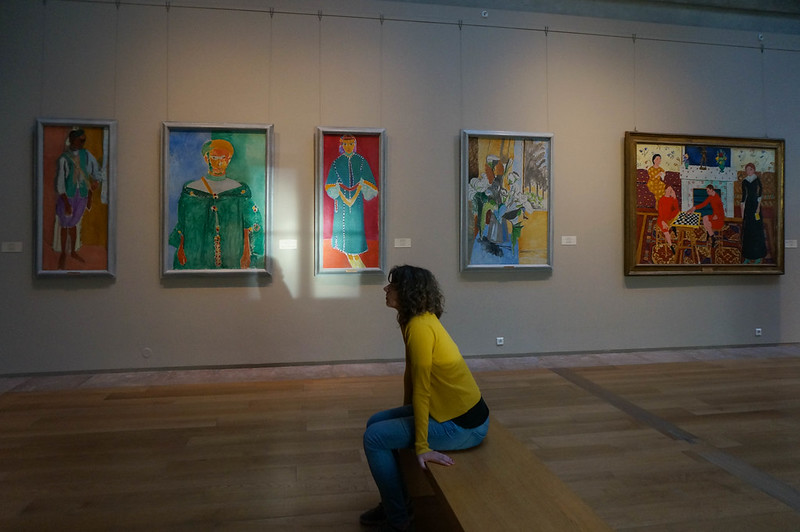
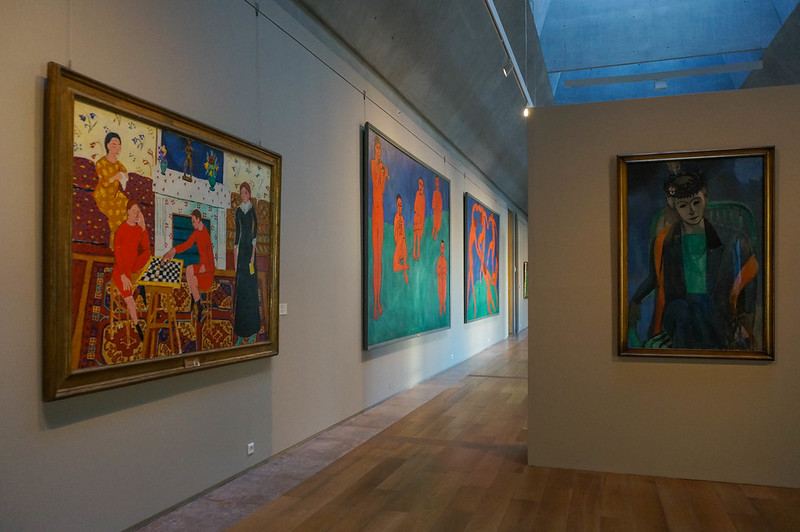
Of Gaugins:
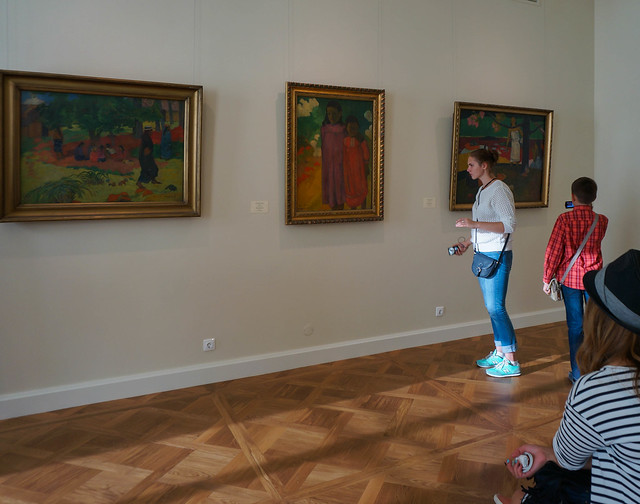
I have never been in a place with such great art with so few people in it.
There are two plausible explanations for it: since the vast majority of people see the Hermitage in a tour group, the tour companies have somehow not managed to make their way over here yet.
Or, equally plausible: the buses and cruise ships simply cannot send groups out in the evening. They have to clear out of here and get the people back to wherever it is that they're spending the night.
Me, I am just awash with delight!
Here, let me immerse you in just a sampling of the art.
Enter the world of Van Gogh with me!
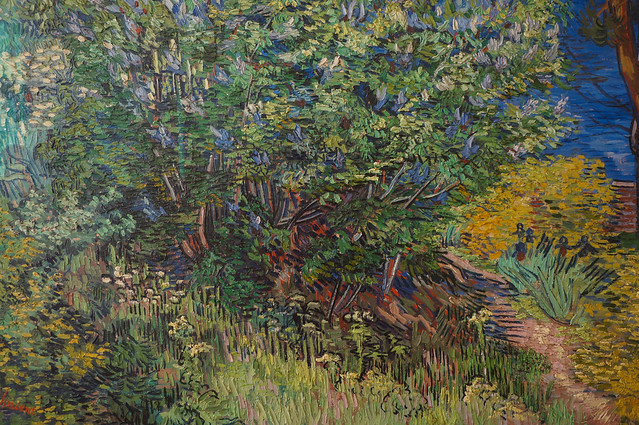
And of Monet:
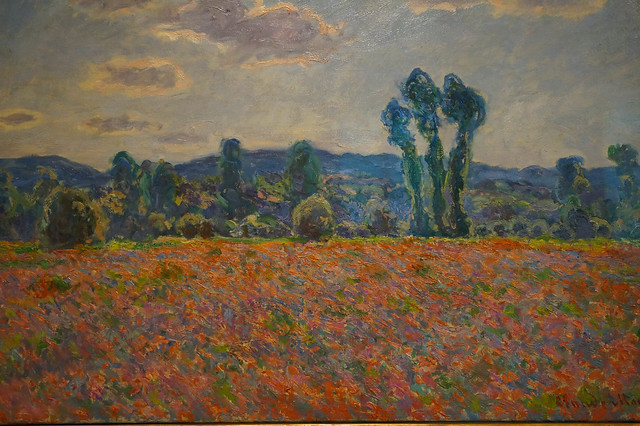
Renoir, Cezanne, Matisse:
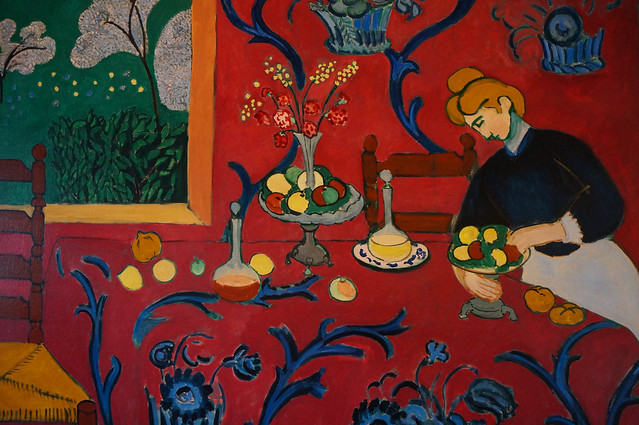
Oh, it is a remarkable set of hours! And the layout is so easy to navigate that I can readily do a second briefer walk through, just to smile and enjoy the entirety of a now known presentation.
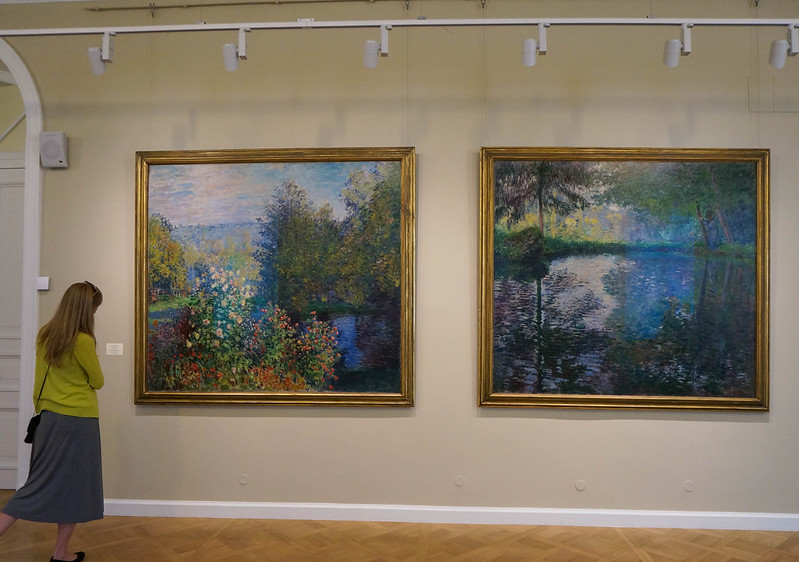
Downstairs, I purchase three very beautiful books.
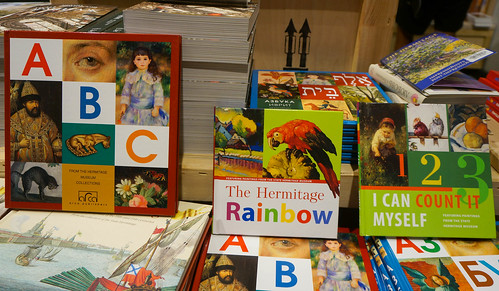
I will bring the Hermitage to Snowdrop. I so look forward to that.
Outside, the light on the square is fading. A guitarist is playing Russian songs. Familiar ones to those who gather. Some people mouth the words with him. I hear "sertse" again and again. The heart. Love songs.
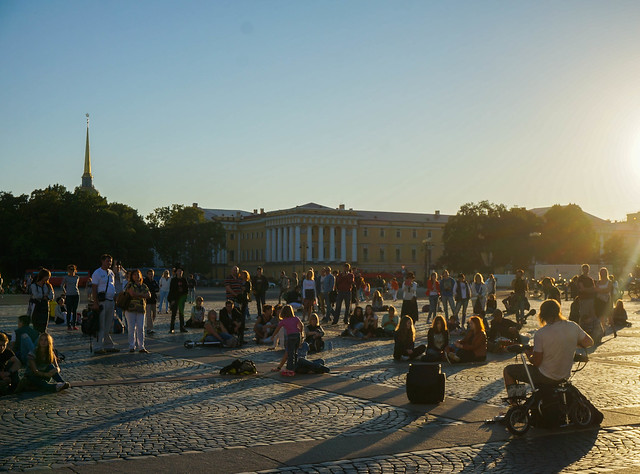
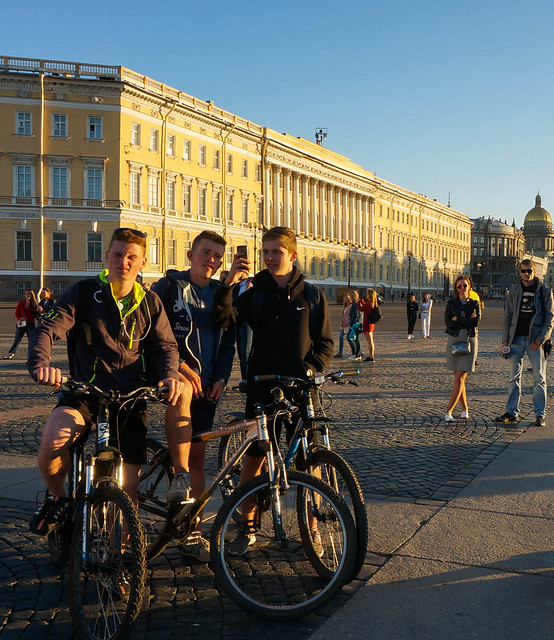
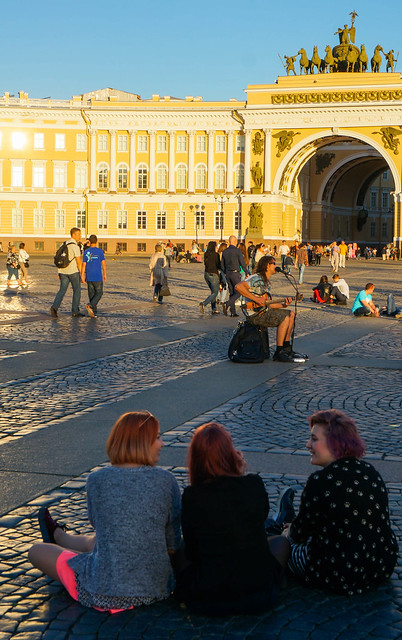
At the other side of the Square, right by the General Staff Building, young men are playing a roller blade hockey game.
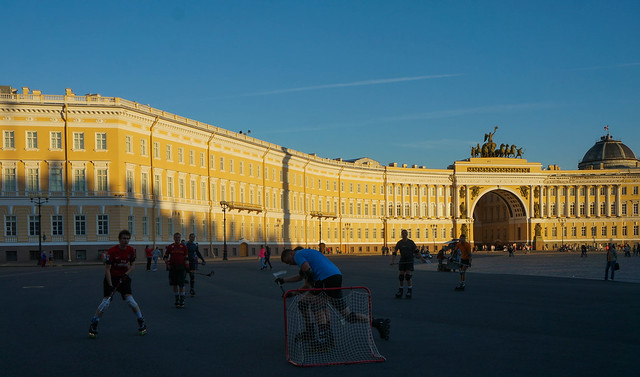
The square has been transformed from a place of great tourism to a place of local use. Of music, sports, friendship.
I linger. I am an outlier -- a tourist, but I linger nonetheless. The moment is too precious to let slip away just yet.
And then I walk along the river back toward my hotel. The sun is setting now over the Trinity Bridge.
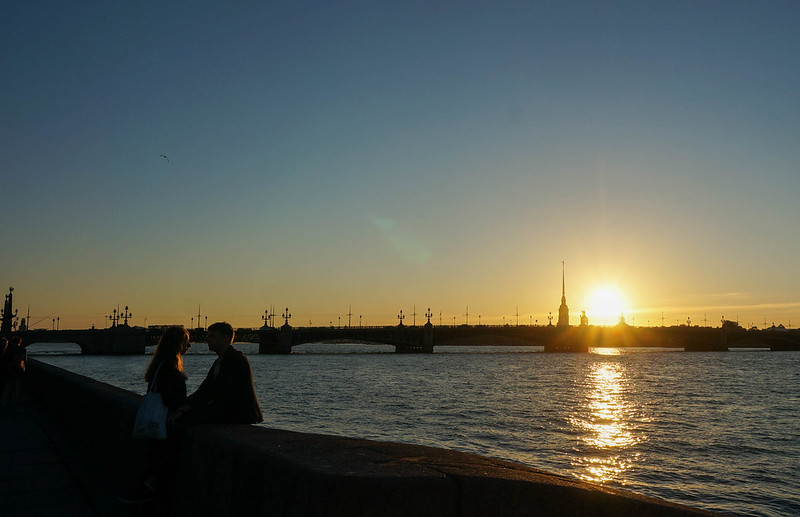
Love blossoms in its golden tones.
Just before returning to my hotel, I stop at a grocery store to buy some evening snacks. Raisins, chocolate, something to drink. And then I go home. It's time to take your foods and bring them home.
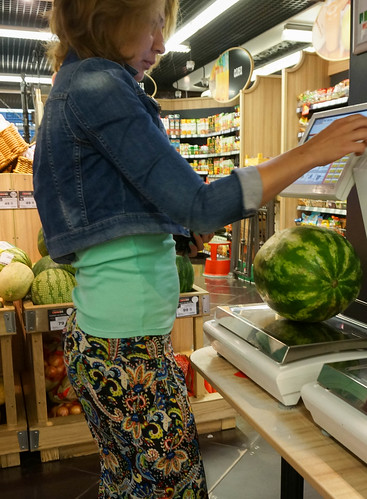


Wonderful. I enjoy your descriptions of places you travel. Is it awkward shooting pictures of people? Do you ask permission first? I don't have themselves! :-)
ReplyDeleteI never ask permission. Well, almost never. I believe in photo journalism. But I am discreet. Most of the people never know I took a picture of them.
Delete"The nerve" ..... not "themselves" . Autocorrect does such strange things sometimes.
ReplyDeleteI had a similar reaction to the works of Vermeer when I visited the Rijksmuseum in Amsterdam in my early twenties. If memory serves, they have the largest collection of his limited oeuvre, and it just astounded me how each painting tells such a rich story in the details. I returned several times to view "Woman Reading a Letter," and it's become my all-time favorite painting. I love all his work, but that one just touches me deeply.
ReplyDeleteYes, in love with the Impressionists, that came for me at an advanced age, 30? 40? at the Field Museum in Chicago, at a special exhibition. I'd seen textbooks, slide shows, note cards, for heaven's sake! but standing in front of these paintings for an extended period of time was a revelation. I'm sure that, like you, it changed my way of seeing.
ReplyDeleteWanting to help people, it's hard to gauge another's need or their pride. Many times at the grocery store, I've said to nearby scooter-shoppers, let me know if I can get anything for you. Sometimes they're glad, sometimes a polite but final "I can manage, thanks". I've learned it's best to see whether they make eye contact or are obviously NOT making eye contact.
Everything there is so spacious. And so many white people. No tired, poor, huddled masses looking for refuge there.
The people look much more prosperous than I might have thought. I'd heard about bread lines, and shift-sharing of the beds. That was firsthand from a friend, but his trip was twenty years ago. Teacher friends travelled there to meet with another teaching group, and this also was twenty years ago. They had individually prepared gift bags with items they'd been told were valued, batteries and pantyhose among them. Then they simply didn't know what was the right thing to do, for exactly the reason you wrote about earlier. They were on an equal footing, and it seemed maybe even disrespectful to give these things. As you said, "distribute largesse". So they got on their charter bus, ready to leave, and then made a collective (emotional) decision to grab their gifts and rush back to say goodbye one more time. They were met with hugs, laughter and tears. Yes, yes, we are happy you came back visit us again so soon! Yes, we are pleased you brought these gifts.
Thanks, Joy... this is a wonderful little story! (So is the blog post that started it... thanks, Nina!)
DeleteWell done. Thanks!
ReplyDeleteI never in a million years would have considered visiting Russia before, but after following along with you and looking at the gorgeous photos, I am rethinking. Thank you.
ReplyDeleteHello Nina: I was struck by your comment regarding how clean and tidy you found St. Petersburg (there is no trash, no litter, no graffiti.) What impressed me during my visit to Moscow and St. Petersburg was that I saw no homeless people or beggars or even aggressive panhandlers. But perhaps the wonder of all wonders was the stunning shopping mall in Moscow, and the gorgeous Kremlin campus. You can see beautiful photos here: http://mobysal.com/russia_photo.php
ReplyDelete